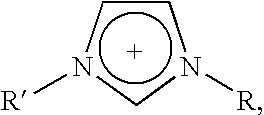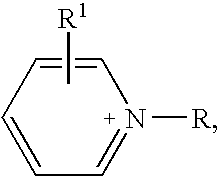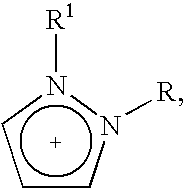Halogen-free ionic liquids
a technology of ionic liquids and halogen-free ionic liquids, which is applied in the field of ionic liquids, can solve the problems of considerable corrosion, environmental problems, and considerable cost, and achieve the effect of improving the stability of aqueous hydrolysis
- Summary
- Abstract
- Description
- Claims
- Application Information
AI Technical Summary
Benefits of technology
Problems solved by technology
Method used
Image
Examples
synthetic example 1
(pyridinium) (Me(O—CH2—CH2)2O—SO3)
To a solution of 10.48 g (87.22 mmol) of diethylene glycol monomethyl ether, 13.9 g of pyridine-SO3 complex (87.22 mmol) is added in small portions at 0° C. The reaction mixture is further stirred at 25° C. for 18 hours. The product is obtained in quantitative yield in the form of a yellowish liquid with a surprisingly low viscosity. The melting point of the substance is below 20° C.
NMR:
1H-NMR (300 MHz, CDCl3): δ=9.03 (d, 2H, CH—(CH—CH)2—N), 8.71 (m, 1H, CH—(CH—CH)2—N), 8.20 (m, 2H, CH—(CH—CH)2—N), 4.25 (tr, 2H, O3—S—O—CH2—CH2—O—CH2—CH2—O—CH3), 3.69 (tr, 2H, O3—S—O—CH2—CH2—O—CH2—CH2—O—CH3), 3.66 (tr, 2H, O3—S—O—CH2—CH2—O—CH2—CH2—O—CH3), 3.54 (tr, 2H, O3—S—O—CH2—CH2—O—CH2—CH2—O—CH3), 3.32 (s, 3H, O3—S—O—CH2—CH2—O—CH2—CH2—O—CH3) ppm.
13C-NMR (75 MHz, CDCl3): δ=147.1, 142.0, 127.8, 71.7, 70.1, 69.5, 66.8, 58.7 ppm.
A general synthetic scheme for this example is depicted in Scheme 1.
synthetic example 2
(pyridinium) (Me(O—CH2—CH2)3—O—SO3)
To a solution of 20.87 g (127.1 mmol) of triethylene glycol monomethyl ether, 20.23 g of pyridine-SO3 complex (127.1 mmol) is added in small portions at 0° C. The reaction mixture is further stirred at 25° C. for 18 hours. The product is obtained in quantitative yield in the form of an almost colorless liquid. The melting point of the substance is below 20° C. A general synthetic scheme for this example is depicted in Scheme 1.
NMR:
1H-NMR (300 MHz, CDCl3): δ=9.02 (d, 2H, CH—(CH—CH)2—N), 8.71 (m, 1H, CH—(CH—CH)2—N), 8.24 (m, 2H, CH—(CH—CH)2—N), 4.25 (tr, 2H, O3—S—O—CH2—CH2—O—CH2—CH2—O—CH2—CH2—O—CH3), 3.77 (tr, 2H, O3—S—O—CH2—CH2—O—CH2—CH2—O—CH2—CH2—O—CH3), 3.65 (m, 6H, O3—S—O—CH2—CH2—O—CH2—CH2—O—CH2—CH2—O—CH3), 3.53 (tr, 2H, O3—S—O—CH2—CH2—O—CH2—CH2—O—CH2—CH2—O—CH3), 3.32 (s, 3H, O3—S—O—CH2—CH2—O—CH2—CH2—O—CH2—CH2—O—CH3) ppm.
13C-NMR (75 MHz, CDCl3): δ=147.1, 142.0, 127.8, 71.6, 70.3-70.1, 69.6, 66.8, 58.8 ppm.
synthetic example 3
(1-butyl-3-methylimidazolium) (Me(O—CH2—CH2)2—O—SO3)
Method 1:
In a sublimation apparatus, 21.88 g of (pyridinium) (Me(O—CH2—CH2)2—O—SO3) (78.33 mmol) (prepared by the method as described in Synthetic Example 1) and 13.68 g of (1-butyl-3-methylimidazolium)Cl (78.33 mmol) are heated at 80° C. under vacuum. Under these conditions, (pyridinium)Cl sublimes from the reaction mixture to precipitate on the cooling surfaces of the sublimation apparatus in the form of white needles. After 8 h, the (pyridinium)Cl is completely removed from the reaction mixture, and the liquid yellowish product with a surprisingly low viscosity can be removed from the sublimation apparatus in quantitative yield. The melting point of the substance is below 20° C. A general synthetic scheme for this example is depicted in Scheme 2.
Method 2:
37.13 g of diethylene glycol monomethyl ether (308.99 mmol) and 30.0 g of sulfamic acid (308.99 mmol) are added to a 250 ml Schlenk flask and heated at 85° C. with stirr...
PUM
| Property | Measurement | Unit |
|---|---|---|
| Temperature | aaaaa | aaaaa |
| Electric charge | aaaaa | aaaaa |
| Melting point | aaaaa | aaaaa |
Abstract
Description
Claims
Application Information
 Login to View More
Login to View More - R&D
- Intellectual Property
- Life Sciences
- Materials
- Tech Scout
- Unparalleled Data Quality
- Higher Quality Content
- 60% Fewer Hallucinations
Browse by: Latest US Patents, China's latest patents, Technical Efficacy Thesaurus, Application Domain, Technology Topic, Popular Technical Reports.
© 2025 PatSnap. All rights reserved.Legal|Privacy policy|Modern Slavery Act Transparency Statement|Sitemap|About US| Contact US: help@patsnap.com



